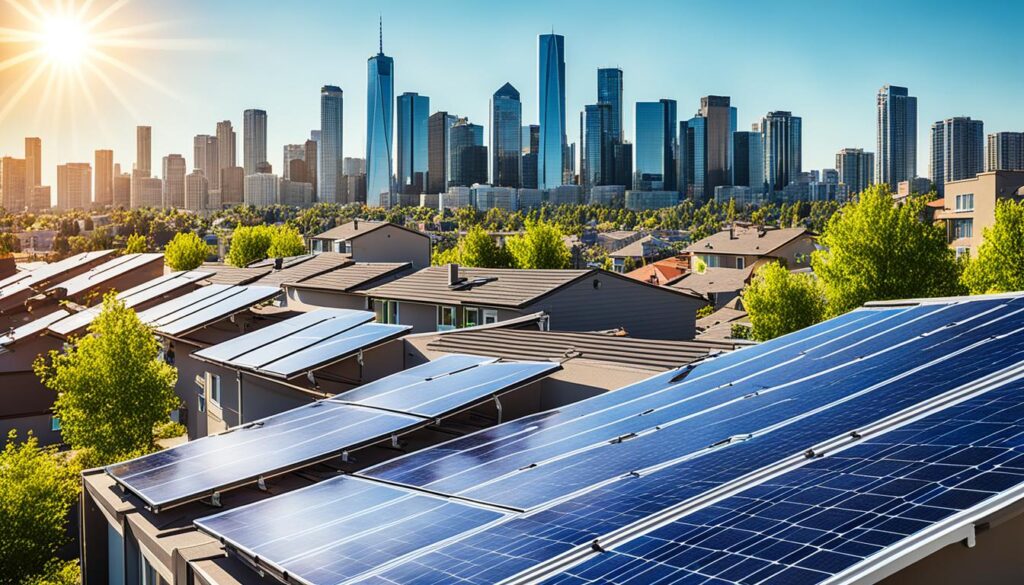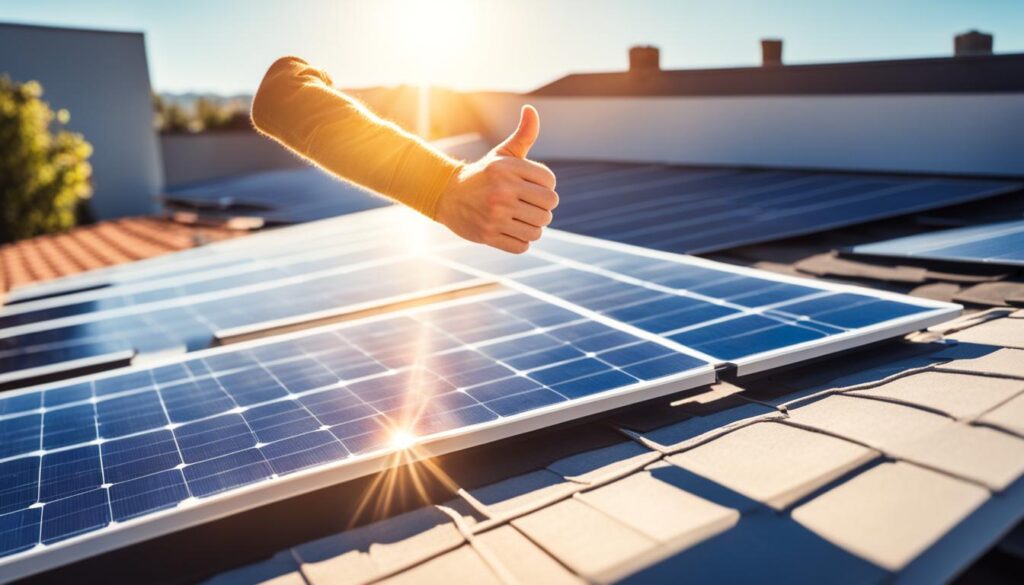India has implemented a subsidy program for solar rooftop systems to encourage the adoption of clean and renewable energy. This program offers financial assistance to residential consumers, reducing the cost of installing solar panels. By taking advantage of this subsidy, homeowners in India can save up to 40% on the benchmark cost of solar rooftop systems.
With a focus on promoting sustainability and reducing carbon emissions, the Indian government has recognized the potential of solar energy in meeting the country’s growing energy demands. By providing a subsidy on solar rooftop installations, the government aims to make renewable energy more accessible and affordable for homeowners. Government subsidy for solar rooftop in india not only helps individuals in reducing their dependence on traditional power sources but also contributes to the overall environmental well-being of the nation.
The Government subsidy on solar rooftop in India is a testament to the government’s commitment to clean energy solutions. By incentivizing the adoption of solar power, this program aims to create a significant impact on India’s energy landscape and contribute to the nation’s sustainable development goals.
Key Takeaways:
- The Indian government has implemented a subsidy program for solar rooftop systems, reducing the cost of installation for residential consumers.
- Homeowners in India can save up to 40% on the installation cost of solar rooftop systems through this subsidy program.
- The subsidy aims to promote sustainability, reduce carbon emissions, and make renewable energy more accessible and affordable for homeowners.
- By incentivizing the adoption of solar power, the subsidy program contributes to India’s sustainable development goals and creates a significant impact on the nation’s energy landscape.
- The subsidy program reflects the government’s commitment to clean and renewable energy solutions.
Overview of the Indian Government’s Solar Rooftop Subsidy
The Indian government has introduced a subsidy program to incentivize the adoption of solar rooftop systems in residential properties. This program aims to reduce the financial burden of installing solar panels and make clean energy more accessible for homeowners. By providing financial assistance, the government is encouraging the use of renewable energy sources to contribute towards a sustainable future.
Goals of the Subsidy Program
“The Indian government’s solar rooftop subsidy program aims to promote the use of solar energy in residential properties.”
The primary goals of the solar rooftop subsidy program are:
- Promoting the use of clean and renewable energy sources
- Reducing dependence on traditional energy sources
- Lowering greenhouse gas emissions
- Encouraging the growth of the solar industry
Central Financial Assistance (CFA): What’s on Offer?
“The central financial assistance (CFA) is a key component of this subsidy program, offering direct benefit transfers to eligible consumers.”
The central financial assistance (CFA) is provided directly to eligible consumers as part of the solar rooftop subsidy program. The CFA varies based on the capacity of the solar system installed. The Indian government offers different subsidy rates for solar systems with capacities up to 3 kW and between 3 kW to 10 kW. Additionally, resident welfare associations and group housing societies are also eligible for subsidies.
The CFA not only helps reduce the overall installation cost but also accelerates the return on investment for homeowners. By providing financial support, the government aims to encourage more people to switch to solar energy and contribute to a greener environment.
Qualifying Solar System Capacities and Corresponding Benefits
The solar rooftop subsidy policy in India provides benefits to different solar system capacities. These benefits are categorized as follows:
| Solar System Capacity | Corresponding Subsidy Benefit |
|---|---|
| Up to 3 kW | INR 18000 per kW |
| Between 3 kW to 10 kW | INR 9000 per kW |
| Resident Welfare Associations/Group Housing Societies | INR 9000 Per kW |
The subsidy scheme ensures that homeowners receive financial support according to the capacity of their solar system. This makes it more attractive and feasible for individuals and communities to install solar rooftop systems, leading to increased adoption of clean energy solutions.
Eligibility for Solar Rooftop Subsidy in India
Eligibility for solar rooftop subsidy in india, residential consumers must meet certain criteria. One of the requirements is that the entire solar project must be implemented through the national portal for rooftop solar. Consumers are also required to get their system installed through empaneled vendors and use domestically manufactured solar panels. Compliance with MNRE guidelines and technical specifications is mandatory.
Solar Rooftop Subsidy application process in India
The application and verification process is done online through the national portal, and consumers can track the progress of their application. Once approved, the subsidy funds are transferred to the consumer’s bank account.

Subsidy on Solar Rooftop in India: How It Reduces Your Energy Costs
The subsidy on solar rooftop installations in India plays a crucial role in reducing energy costs for homeowners. By providing financial assistance, this subsidy significantly lowers the upfront investment required for installing solar panels on rooftops. As a result, homeowners can enjoy substantial savings on their energy bills in the long run.
Calculation of the Subsidy Amount
The subsidy amount for solar rooftop systems in India is determined by the capacity of the system. Generally, the higher the capacity, the higher the subsidy amount. The exact calculation methodology varies and is based on the guidelines set by the Ministry of New and Renewable Energy (MNRE). By covering a significant portion of the installation cost, the subsidy reduces the payback period for homeowners, making solar rooftop systems more financially viable.
State-Specific Additional Subsidies
In addition to the central financial assistance provided by the Indian government, some states offer their own separate subsidies to further incentivize the adoption of solar rooftop systems. These state-specific subsidies vary in terms of eligibility criteria and subsidy amounts. Homeowners should check with their respective state authorities or consult local solar installers to explore any additional subsidies available in their region. By taking advantage of these state-specific subsidies, homeowners can maximize their financial benefits and make the transition to solar energy even more affordable.
National Portal for Rooftop Solar: Streamlining the Process
The Indian government has launched a national portal for rooftop solar to streamline the entire application process for the solar rooftop subsidy program. This online platform allows eligible consumers to apply for the subsidy conveniently from the comfort of their homes. The portal also enables consumers to track the progress of their application and receive updates on the subsidy disbursement. By providing an efficient and transparent system, the national portal for rooftop solar simplifies the entire process, making it easier for homeowners to access the subsidy and embrace clean energy.
Conclusion
Impact on Residential Solar Adoption: The introduction of the subsidy on solar rooftop installations in India has had a significant impact on the adoption of residential solar systems. By reducing the financial burden and making solar energy more affordable, the subsidy program has encouraged homeowners to switch to clean and renewable energy sources. This has led to a steady increase in the number of households installing solar rooftop systems and contributing to the country’s renewable energy goals.
Future Prospects of Solar Rooftop Incentives in India: The future prospects for solar rooftop incentives in India look promising. The government’s continued efforts to promote solar energy, along with advancements in technology and increased awareness among the general public, create a favorable environment for the widespread adoption of solar rooftop systems. As more households embrace clean energy solutions, the demand for solar installations is expected to rise, further driving the growth of the solar industry in India.
With its numerous environmental and economic benefits, solar energy has the potential to become a mainstream source of power for Indian households. As the government continues to support solar rooftop incentives and implement favorable policies, it is likely that more homeowners will recognize the long-term advantages of going solar. By harnessing the power of the sun, Indian households can contribute to a greener future while enjoying reduced energy costs and a more sustainable lifestyle.
FAQ
What is the Indian government’s solar rooftop subsidy program?
The Indian government’s solar rooftop subsidy program is a scheme aimed at promoting the use of solar energy in residential properties by providing financial assistance to homeowners.
What is the central financial assistance (CFA) offered under the solar rooftop subsidy program?
The central financial assistance (CFA) is a key component of the Indian government’s solar rooftop subsidy program. It offers direct benefit transfers to eligible consumers, with the subsidy amount varying based on the capacity of the solar system.
What are the qualifying solar system capacities and corresponding benefits under the subsidy program?
The subsidy program provides different benefits based on the capacity of the solar system. Benefits are available for capacities up to 3 kW, between 3 kW to 10 kW, and for resident welfare associations/group housing societies.
What are the eligibility criteria for the solar rooftop subsidy in India?
To be eligible for the solar rooftop subsidy in India, residential consumers must meet certain criteria, including implementing the entire solar project through the national portal for rooftop solar, using empaneled vendors, and domestically manufactured solar panels. Compliance with MNRE guidelines and technical specifications is also mandatory.
How can I apply for the solar rooftop subsidy in India?
The application and verification process for the solar rooftop subsidy scheme in India is done online through the national portal. Residential consumers can apply for the subsidy, track the progress of their application, and once approved, the subsidy funds are transferred directly to their bank account.
How does the subsidy on solar rooftop installations in India reduce energy costs?
The subsidy amount is calculated based on the capacity of the solar system. By covering a substantial portion of the installation cost, the subsidy significantly reduces the financial burden on homeowners, resulting in lower energy costs over time.
Are there any state-specific additional subsidies available for solar rooftop installations in India?
Yes, some Indian states provide their own separate state-specific subsidies in addition to the central financial assistance. These additional subsidies further promote the adoption of solar rooftop systems by reducing the overall cost for homeowners.
How does the national portal for rooftop solar streamline the solar rooftop subsidy application process?
The national portal for rooftop solar has been launched to make it easier for consumers to apply for the subsidy online and track the progress of their application. It streamlines the entire process, ensuring efficiency and transparency.
What is the impact of the solar rooftop subsidy program on residential solar adoption?
The solar rooftop subsidy program in India significantly encourages homeowners to switch to clean and renewable energy sources by reducing the financial burden and making solar energy more affordable. It has a positive impact on the adoption of residential solar systems.
What are the future prospects of solar rooftop incentives in India?
With advancements in technology and increased awareness, there is a great potential for solar energy to become a mainstream source of power in Indian households. As the government continues to promote solar rooftop incentives, the future prospects for solar adoption in India are promising.

